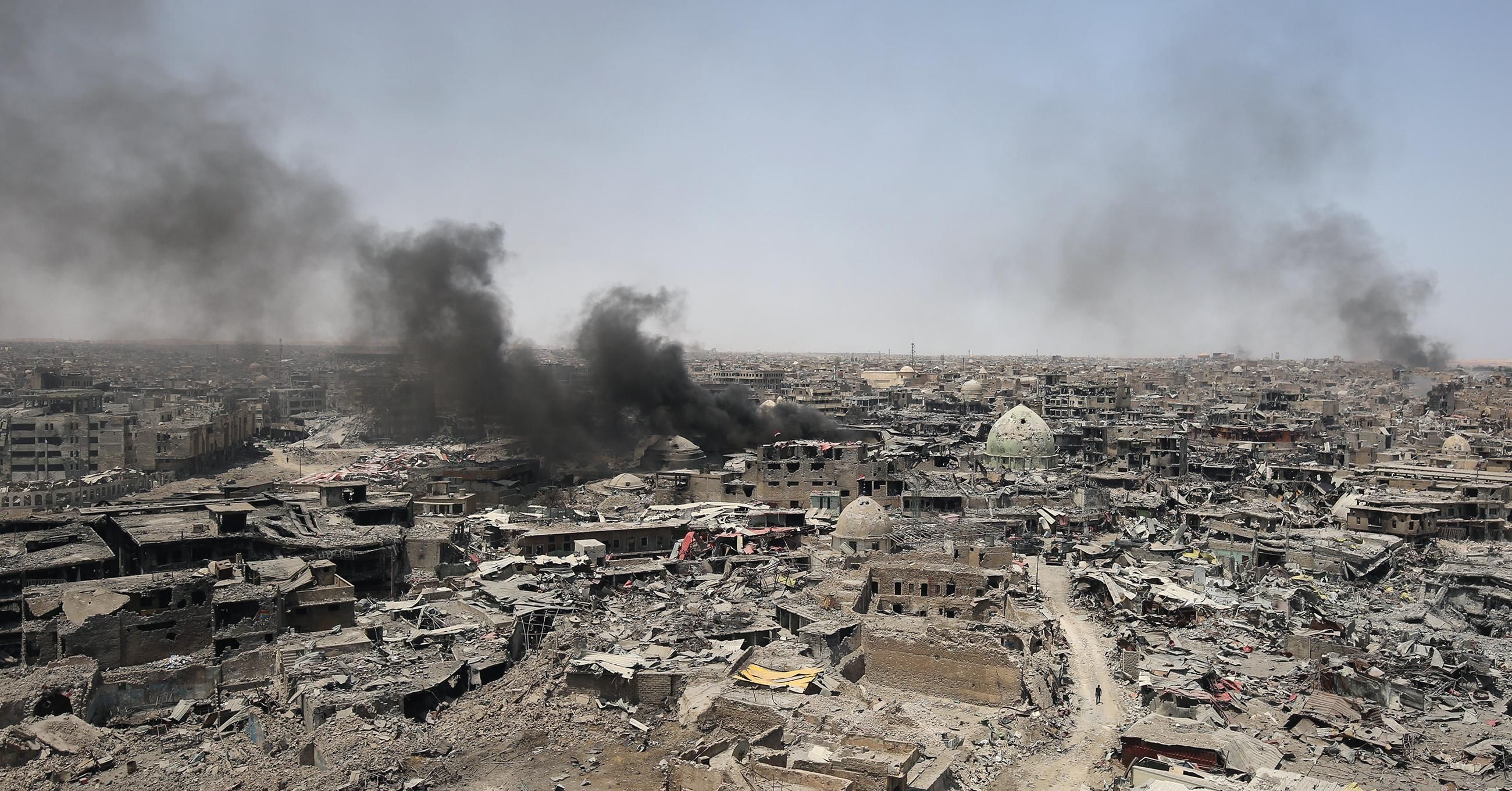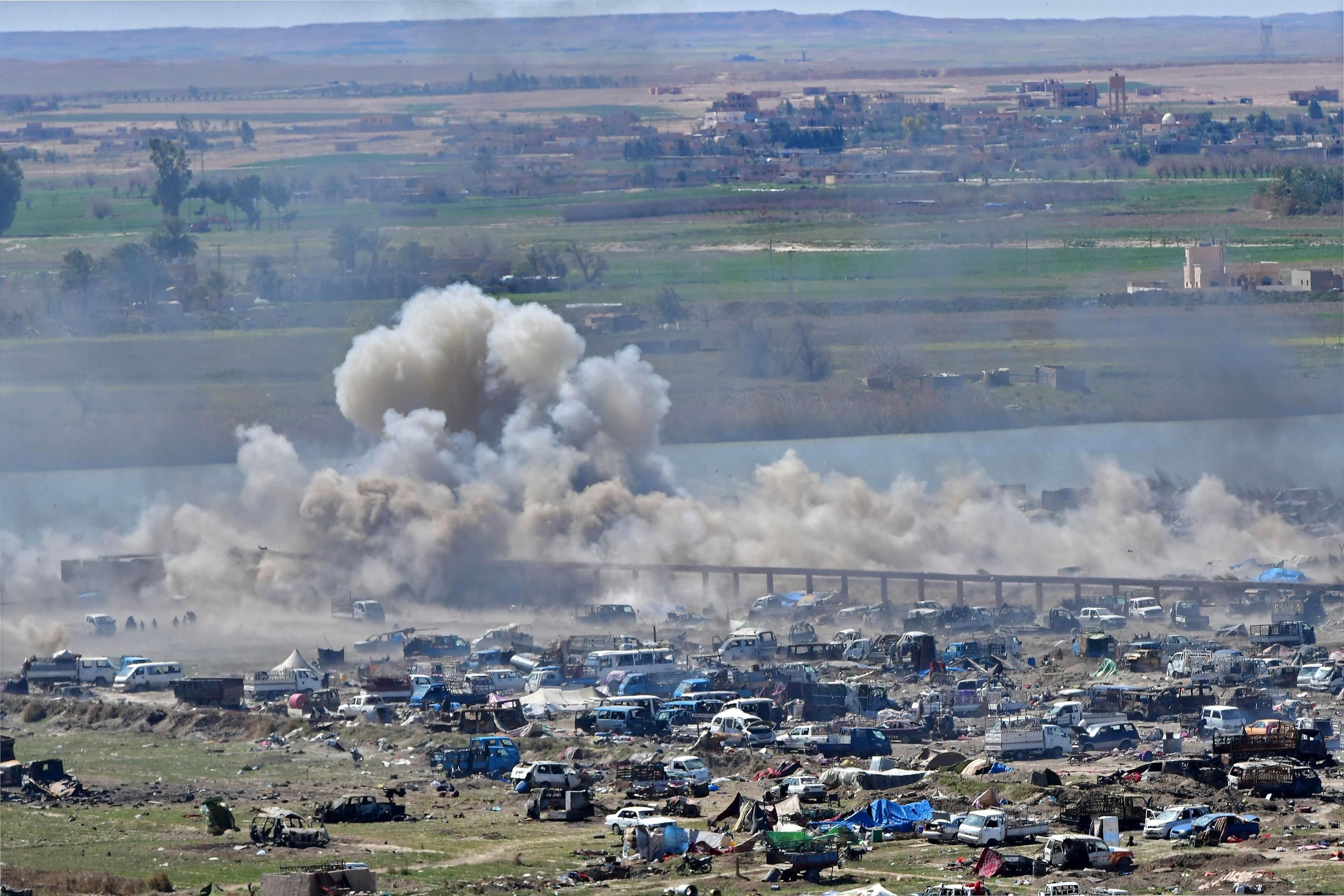"In too many instances, U.S. drone strikes have instead led to unintended and deadly consequences—killing civilians and increasing anger towards the United States."

The Iraqi city of Mosul was largely destroyed during fighting between U.S.-led coalition forces and Islamic State militants in 2017. Thousands of civilians were killed or wounded, many of them by ferocious U.S. and allied aerial bombing. (Photo: Ahmad al-Rubaye/AFP via Getty Images)
BRETT WILKINS
COMMONDREAMS
January 20, 2022
A group of 50 Democratic U.S. lawmakers on Thursday sent a letter to President Joe Biden focusing on the "inexcusable" number of noncombatants killed by drone strikes in the 20-year so-called War on Terror and urging his administration to "review and overhaul" American counterterrorism policy to "center human rights and the protection of civilians."
"In far too many cases, rather than achieving the policy goal of eliminating hostile combatants to preserve U.S. national security, lethal U.S. strikes have instead killed thousands of civilians."
"The continuation of status quo policies that have flouted executive and congressional oversight and resulted in devastatingly high numbers of civilian casualties would run contrary to the Biden administration's commitments to end our forever wars, and promote human rights and our core democratic values," the letter—which is led by Sen. Elizabeth Warren (D-Mass.), Sen. Chris Murphy (D-Conn.), and Rep. Ro Khanna (D-Calif.)—states.
"Over successive administrations spanning nearly two decades, presidents have claimed virtually unlimited, unilateral power to use lethal force around the world and without congressional authorization, killing not only armed actors but also innocent civilians—even American citizens," the lawmakers add.
"In too many instances, U.S. drone strikes have instead led to unintended and deadly consequences—killing civilians and increasing anger towards the United States," the signers note.
The letter cites figures by the monitoring group Airwars estimating that "as many as 48,000 civilians across seven countries have reportedly been killed by U.S. strikes over the past two decades." That figure includes not only drone attacks but all aerial bombardment.
"These inexcusable figures reflect an uncomfortable truth: In far too many cases, rather than achieving the policy goal of eliminating hostile combatants to preserve U.S. national security, lethal U.S. strikes have instead killed thousands of civilians, including children," the letter states.
The Democrats' letter followed publication by The New York Times of video footage of an August 29 U.S. drone strike that killed 43-year-old Afghan aid worker Zamarai Ahmadi and nine of his relatives—including seven children—in the capital city of Kabul.
The U.S. military said the Kabul strike was carried out in the belief that Ahmadi was loading explosives into his car, and that an attack by militants of the so-called Islamic State (ISIS) on Kabul's international airport was imminent. U.S. Joint Chiefs of Staff Chair Gen. Mark Milley called the bombing a "righteous strike."
However, investigations by the Times and The Washington Post, as well as the Pentagon's own probe, concluded that—contrary to the military's claims—there were no explosives in the car, and that the men accused of suspicious behavior were engaged in activities related to Ahmadi's work.
The letter cites the Kabul strike, as well as a March 18, 2019 U.S. airstrike in Baghuz, Syria carried out by a secret drone task force in which around 70 civilians died—and which military officials allegedly tried to cover up—as proof of the need for fundamental reform.
"Without systematic reforms centered on human rights and international law, the status quo will continue to undermine counterterrorism objectives, produce significant human and strategic costs, and erode the rule of law and the United States' image abroad," the lawmakers assert.
A group of 50 Democratic U.S. lawmakers on Thursday sent a letter to President Joe Biden focusing on the "inexcusable" number of noncombatants killed by drone strikes in the 20-year so-called War on Terror and urging his administration to "review and overhaul" American counterterrorism policy to "center human rights and the protection of civilians."
"In far too many cases, rather than achieving the policy goal of eliminating hostile combatants to preserve U.S. national security, lethal U.S. strikes have instead killed thousands of civilians."
"The continuation of status quo policies that have flouted executive and congressional oversight and resulted in devastatingly high numbers of civilian casualties would run contrary to the Biden administration's commitments to end our forever wars, and promote human rights and our core democratic values," the letter—which is led by Sen. Elizabeth Warren (D-Mass.), Sen. Chris Murphy (D-Conn.), and Rep. Ro Khanna (D-Calif.)—states.
"Over successive administrations spanning nearly two decades, presidents have claimed virtually unlimited, unilateral power to use lethal force around the world and without congressional authorization, killing not only armed actors but also innocent civilians—even American citizens," the lawmakers add.
"In too many instances, U.S. drone strikes have instead led to unintended and deadly consequences—killing civilians and increasing anger towards the United States," the signers note.
The letter cites figures by the monitoring group Airwars estimating that "as many as 48,000 civilians across seven countries have reportedly been killed by U.S. strikes over the past two decades." That figure includes not only drone attacks but all aerial bombardment.
"These inexcusable figures reflect an uncomfortable truth: In far too many cases, rather than achieving the policy goal of eliminating hostile combatants to preserve U.S. national security, lethal U.S. strikes have instead killed thousands of civilians, including children," the letter states.
The Democrats' letter followed publication by The New York Times of video footage of an August 29 U.S. drone strike that killed 43-year-old Afghan aid worker Zamarai Ahmadi and nine of his relatives—including seven children—in the capital city of Kabul.
The U.S. military said the Kabul strike was carried out in the belief that Ahmadi was loading explosives into his car, and that an attack by militants of the so-called Islamic State (ISIS) on Kabul's international airport was imminent. U.S. Joint Chiefs of Staff Chair Gen. Mark Milley called the bombing a "righteous strike."
However, investigations by the Times and The Washington Post, as well as the Pentagon's own probe, concluded that—contrary to the military's claims—there were no explosives in the car, and that the men accused of suspicious behavior were engaged in activities related to Ahmadi's work.
The letter cites the Kabul strike, as well as a March 18, 2019 U.S. airstrike in Baghuz, Syria carried out by a secret drone task force in which around 70 civilians died—and which military officials allegedly tried to cover up—as proof of the need for fundamental reform.
"Without systematic reforms centered on human rights and international law, the status quo will continue to undermine counterterrorism objectives, produce significant human and strategic costs, and erode the rule of law and the United States' image abroad," the lawmakers assert.
Related Content

'Infuriating' Report Reveals 'Breathtaking Cover-Up' of US Airstrike That Killed Syrian Civilians
Jessica Corbett
"When there is little policy change or accountability for repeated mistakes this grave and this costly, it sends a message throughout the U.S. armed forces and the entire U.S. government that civilian deaths—including deaths where there was no military target—are the inevitable consequence of modern conflict, rather than avoidable and damaging failures of policy," they add.
The letter also comes a day after Reps. Pramilia Jayapal (D-Wash.) and Barbara Lee (D-Calif.)—both signatories—introduced a resolution calling for a new American foreign policy that centers nonviolent solutions and eschews militarism and bloated Pentagon budgets.
Lee, who in 2001 was the only member of Congress to vote against the Authorization for the Use of Military Force that authorized the open-ended and continuing War on Terror, said that "the post 9/11 wars taught us that perpetual war takes countless lives, wastes trillions of dollars, and does not make us any safer."
In a statement, Warren said that "we cannot ignore the terrible consequences of U.S. drone strikes over several administrations. I've long pushed for greater accountability for civilian casualties, and the president should seize this moment to systematically reform our counterterrorism strategy."
Murphy argued that "when U.S. strikes kill civilians abroad, it's both a moral failure and national security liability."
"There's no doubt Biden takes this issue more seriously than [former President Donald] Trump, but we can and must do better," he added. "The U.S. should use force only lawfully and as a last resort, and when civilians die, there has to be accountability. That accountability simply has not been happening."
:quality(70)/cloudfront-us-east-1.images.arcpublishing.com/mco/LH3UDQGN5BCFTIPLNIAICZU6SA.png)
:quality(70)/cloudfront-us-east-1.images.arcpublishing.com/mco/V3557RO6XVFLZCEW57NTBXKF5M.png)
:quality(70)/cloudfront-us-east-1.images.arcpublishing.com/mco/4DPKVTIGARFVFFDLAKFAOYNHR4.png)










